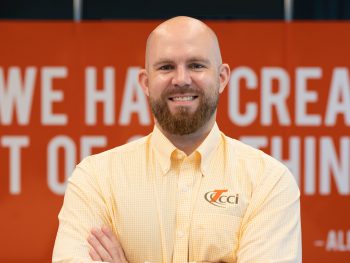Electrification is the answer – but how do we get there?
By Jacob Scott, director of product management for electric compressors for TCCI Manufacturing
Electric vehicle adoption is happening at a rapid pace, but we still have a long way to go to achieve ambitious goals such as a 50% market share by 2030.
In the US, EVs account for only 6% of all vehicles on the road.
To adopt cleaner transportation and reduce emissions, it’s going to take collective buy-in from every corner of the transportation sector, which is responsible for about one-third of carbon emissions in the US.
In my current role as director of product management for electric compressors for TCCI Manufacturing, I think not only about electrifying our own products and processes but also the industry as a whole.
Here are three areas I believe will be critical in achieving ambitious electrification goals:
1. Public–private partnerships
One of the essential steps in reaching widespread EV adoption is to establish and strengthen public–private partnerships.
Collaboration between all companies within the supply chain, higher education institutions, and local, state, and federal governments are critical for upskilling the existing workforce as well as developing training and curriculum for the growing EV industry.
Manufacturers can work with their supply chain partners, higher education institutions, and local governments to build STEM pathways, certificates, stackable credentials and apprenticeship programs that will support the proliferating green economy.
A successful example in our own backyard is the Rebuild Illinois program. The state granted $15.3m to Richland Community College and $6m to the City of Decatur to work side-by-side to develop a three-tiered facility at TCCI Manufacturing in Decatur. This collaborative public–private partnership model will connect expertise across organizations to co-create a premier EV research and training facility. The power of this partnership will be leveraged to increase exposure to industry partners, conduct research to advance innovation and disruptive technologies, and develop a new model to accelerate a workforce solution for the growing EV industry.
This clustering of expertise is pushing the industry forward.
Additionally, the Reimagining Electric Vehicles in Illinois (REV Illinois) program has set the tone for the state’s commitment to sustainable transportation with competitive incentives to attract companies all along the supply chain for EVs.
2. Testing and validation
Most facilities and processes are geared towards testing internal combustion engines, making it difficult to test the charging, range, and emissions of EVs. The development of specialized testing facilities will be crucial to advance EV technology and ensure zero-emission goals.
Manufactured products should be tested under intense, real-world conditions in order to determine longevity, durability and performance. Compared with standard internal combustion engine vehicles, there is a new set of factors to consider with EVs. In addition to HVAC, cooling systems must be able to handle the load of battery cooling. Cooling is even more critical in electric vehicles because maintaining optimal battery temperatures is crucial to guaranteeing the effective range of the vehicle.
By ensuring the testing and validation processes are comprehensive, we will see continued improvement in the quality of EVs. To achieve electrification goals, we have to support testing, technology advancement, and full-scale climatic testing for high voltage systems, battery cooling, and both A/C and heat pump capabilities.
3. Advance new compressor technologies
The compressor is the most critical component for cooling systems and their importance drastically increases in the EV space.
For EVs, the compressor cools the cabin of the vehicle and the battery, while also ensuring the longevity of the battery. As EVs become more widely adopted, the industry must alleviate consumer concerns around range anxiety with faster charging capabilities. Charging at faster rates creates a unique thermal situation in which the actual batteries are seeing more thermal load from the charging system than they would otherwise see from environmental influence.
As much as engineers can design around parameters that affect the compressor as an individual component, there are many external factors that are driven by the OEM that can have an impact on the performance of the system as a whole. For example, if you look at an HVAC system, the compressor controls the flow of the refrigerant through the system, but other factors such as spacing, alignment, size, air flow and surface area of other components all contribute to the overall performance of the system in a vehicle.
Of course, fleet operators must consider factors such as the cost of EVs, the availability of charging infrastructure, and the range of the vehicles. These challenges will be more easily addressed if we focus on the three areas above.
Achieving the goal of 50% EV adoption by 2030 requires buy-in from all stakeholders, improvements in testing and validation, and the advancement of compressor technology. There should be a greater sense of urgency amid supply chain challenges and the war in Ukraine, which has underscored the need to shift away from relying on fossil fuels.
As fleet operators, transitioning to EVs can reduce carbon emissions and contribute to a cleaner environment. By working together on these items, the transition should also be economically and logistically beneficial. With effective collaboration, we will reach our electrification goals and move the industry forward.
Jacob Scott is director of product management for TCCI, which pioneers technology in electrification and supports customer plans for full electrification solutions including vehicle production and charging.








